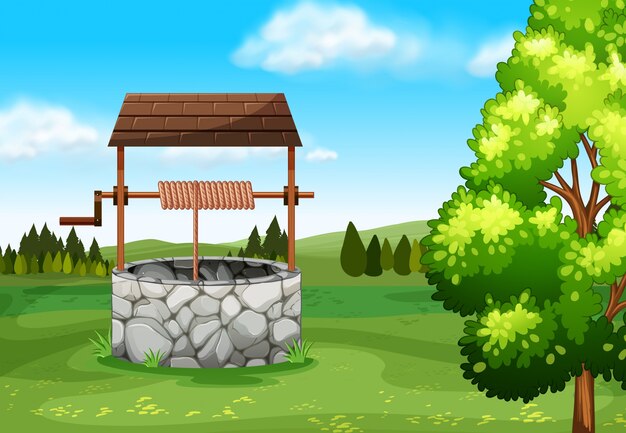Introduction: The Enchantment of a Wishing Well
Have you ever tossed a coin into a wishing well and made a silent wish? There’s something magical about that moment—the hope, the anticipation, the belief that maybe, just maybe, your wish will come true. Wishing wells have been part of human culture for centuries, symbolizing luck, prosperity, and even divine blessings.
But where did this tradition come from? And why do people still throw coins into wells, fountains, and ponds? In this article, we’ll dive into the fascinating history of wishing wells, their cultural significance, and how they are still use today.
The History of Wishing Wells
The concept of a wishing well dates back to ancient times, with roots in various cultures across the world.
1. Ancient European Beliefs
The idea of tossing coins into a well comes from European folklore. Ancient Germanic and Celtic tribes believed that water had special powers, often linked to gods or spirits. Since wells provide clean drinking water—something vital for survival—people thought they were gifts from the divine. By offering a coin, they believed they were giving thanks and could receive blessings in return.
2. Roman Influence
The Romans also had a similar tradition. They threw coins into sacred fountains dedicated to gods like Neptune (god of the sea) and Juno (goddess of marriage and prosperity). This practice spread across Europe, influencing local customs and shaping what we now know as the wishing well tradition.
3. Norse Mythology and Mimir’s Well
In Norse mythology, there is a famous well called “Mimir’s Well.” It was said to grant wisdom to those who drank from it, but at a cost. Odin, the chief god, sacrificed one of his eyes to gain knowledge from the well. This legend adds another layer to the idea that wells hold mysterious, magical properties.
Why Do People Throw Coins into Wishing Wells?
Even though most people don’t believe in magic today, the tradition of throwing coins into wells and fountains is still alive. But why?
1. Superstition and Luck
Many people believe that throwing a coin into a wishing well brings good luck. Some think that if your coin lands heads up, your wish is more likely to come true.
2. Cultural and Religious Roots
Many cultures have long-held beliefs about water being sacred. Some see it as a way to ask for guidance, blessings, or protection.
3. Fun and Tradition
Let’s be honest—throwing a coin into a well is just fun! It’s something children and adults enjoy, whether at a historical site, a theme park, or a city fountain.
Modern Uses of Wishing Wells
Wishing wells have evolved beyond their original purpose. Today, they serve various functions in different settings.
1. Wedding Wishing Wells
At weddings, a “wishing well” is often a decorative box or container where guests can drop cards, money, or well-wishes for the couple. It symbolizes blessings for a prosperous marriage.
2. Charity and Fundraising
Many public fountains and wells collect coins, which are later donated to charities. For example, the coins thrown into Rome’s famous Trevi Fountain go toward helping the needy.
3. Tourist Attractions
Some historical wishing wells have become famous attractions. People visit, toss in coins, and take part in the centuries-old tradition.
Interesting Facts About Wishing Wells
- The Trevi Fountain in Rome collects about $1.5 million per year from tossed coins, all of which go to charity.
- In some cultures, making a wish in complete silence increases its chances of coming true.
- Some wishing wells in castles were believed to be “love wells,” where young women would drop a pin to see if their love was true.
How to Make Your Own Wishing Well at Home
Want to create a wishing well in your backyard? Here’s how:
Materials Needed:
✔ A small wooden barrel or pot
✔ A wooden frame or decorative arch
✔ Some stones or pebbles for decoration
✔ A small bucket (optional)
✔ Coins for making wishes
Steps:
- Place the barrel in your garden and fill it with water.
- Decorate it with stones, flowers, or fairy lights.
- Attach a wooden frame above it to mimic an old-fashioned well.
- Add a small bucket for extra charm.
- Start making wishes!
Conclusion: The Enduring Magic of Wishing Wells
Despite changing times, the magic of a wishing well remains strong. Whether rooted in history, superstition, or just pure fun, people continue to toss coins and hope for the best. While we may not know if wishes actually come true, the act of making one brings a little joy, and sometimes, that’s all we need.
Next time you come across a wishing well, take a moment, make a wish, and embrace the magic!
FAQs About Wishing Wells
1. Do wishing wells actually make wishes come true?
There’s no scientific proof, but many people believe in the power of positive thinking and tradition.
2. Why do people throw coins instead of other objects?
Coins symbolize prosperity and were historically linked to offerings for gods and spirits.
3. What happens to the coins in public fountains and wells?
Many places collect and donate the coins to charity, while some are used for maintenance.
4. Can I make a wishing well at home?
Yes! You can create a decorative wishing well in your garden or even a small tabletop version for fun.
5. Is there a specific way to make a wish?
Some believe wishes should be made silently and that you shouldn’t tell anyone what you wished for.
6. Are there famous wishing wells in the world?
Yes! The Trevi Fountain in Rome and the Coventina’s Well in England are among the most famous.




